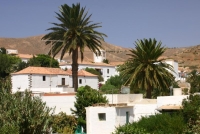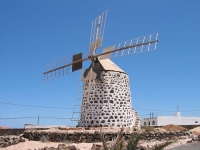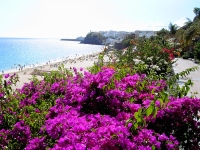Things to do in Fuerteventura
Fuerteventura is famous for its gorgeous beaches, which range from stretches of white sands in the south to the odd black-sand beaches in the north. There are also charming little villages and harbours to enjoy, and a laidback ambiance characterises the entire island. Fuerteventura doesn't have the glamorous nightlife or high-end attractions of some other Balearic destinations, but those visiting to enjoy its wholesome charms will not be disappointed.
Puerto del Rosario is the main town and the most popular resorts are Correlejo and Caleta del Fuste. However, to really experience local charm, visitors should head to rustic little villages such as El Cotillo and La Oliva, or the historic old town of Betancuria.
The island's regular winds make it a good destination for water sports such as windsurfing and kite surfing, and other fun activities include glass-bottomed boat adventures and camel rides on the beach. Families travelling with kids should try out the Baku Water Park and Fuerteventura Oasis Park.
Car hire is good value and most visitors tend to rent a vehicle by the week to get around Fuerteventura at their leisure. Public transport is decent, though, with reliable and cheap buses, and ferries that are useful for getting from one side of the island to the other.

Betancuria
The old town of Betancuria was founded in 1405 and was the first capital of Fuerteventura. The town enjoys a fantastic location that offers attractive views of the hilly terrain an…
Betancuria
The old town of Betancuria was founded in 1405 and was the first capital of Fuerteventura. The town enjoys a fantastic location that offers attractive views of the hilly terrain and winding river below. There are several beautiful buildings and churches worth visiting in the town, including the Church of Iglesia de Santa Maria de Betancuria and the convent of San Buenaventura. The Casa Museo Arquebiologico has some interesting artefacts including fertility idols and farming tools that reflect the earliest history of the island. The town was built primarily to defend against pirate attacks was all but destroyed by pirates in 1593. There are various shops and stalls in Betancuria that sell some of the best handcrafts and local produce on Fuerteventura.

La Oliva
Historic buildings from between the 17th and mid-19th centuries remain in the village of La Oliva, which people can still visit. Travellers should make their way to the centre of t…
La Oliva
Historic buildings from between the 17th and mid-19th centuries remain in the village of La Oliva, which people can still visit. Travellers should make their way to the centre of the village, where they'll find the pretty church of Parroquiade Nuestra Seiiora de Candelaria. Its highlights include a square bell tower, a finely carved wooden door, an interior that features a painting of the Last Judgement, a Baroque altar painting by Juan de Miranda, and some wonderful trompe l'oeil work. The village also has an art centre exhibiting the work of Canarian artists (Centro de Arte Canario Casa Mane). The somewhat desolate and barren natural landscape of the interior gives way dramatically to the bright turquoise water of the sea, and the beaches around La Oliva are very pretty.

Beaches on Fuerteventura
Travellers won't need to go far on Fuerteventura to find a perfect beach, even if they are intent on seeking solitude from other holidaymakers. The best are found around Jandia on …
Beaches on Fuerteventura
Travellers won't need to go far on Fuerteventura to find a perfect beach, even if they are intent on seeking solitude from other holidaymakers. The best are found around Jandia on the southern tip of the island. Juan Gomez is one of these and has an enticing stretch of golden sand. The black-pebble volcanic beach of La Pared is in the same part of the island. Giniginamar is surrounded by palm trees and other indigenous plants and is recommended for peace and quiet. If travellers are looking for a family-friendly beach, the southern Costa Calma is a great option as the conditions are ideal for safe swimming and the facilities are good. Nudism is tolerated on all the island's beaches.



